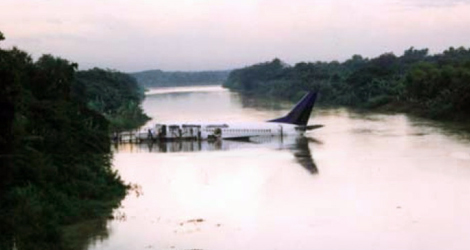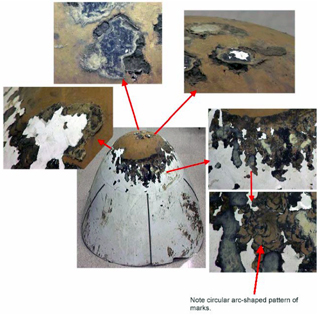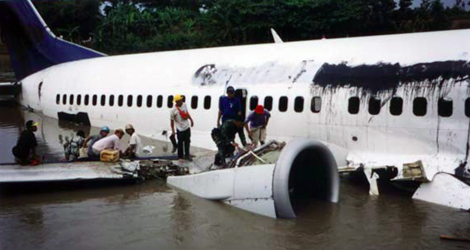On January 16, 2002, at approximately 09:24 UTC, Garuda Indonesia flight GA421 , a Boeing 737-300, PK-GWA, ditched into the waters of the Bengawan Solo River, Central Java during a forced landing, following loss of power on both engines as the aircraft was descending through 19,000 ft. The dual engine flame out occurred shortly after the aircraft entered severe cumulonimbus cloud formations with turbulence and heavy rain and ice.

Garuda Indonesia flight GA421 – Boeing B737-300 (PK-GWA)
The aircraft, Garuda Indonesia flight GA 421, had departed Ampenan at 08:32 UTC, on a regular scheduled commercial flight with destination Yogyakarta. At departure VMC conditions prevailed. The flight from Ampenan was reported uneventful until its arrival in the Yogyakarta area. The crew of Garuda Indonesia flight GA421 stated that they observed cumulonimbus cloud formations on their weather radar. The aircraft descended from cruise altitude of 31,000 ft to 28,000ft as instructed by BALI ATC at 09.08 UTC due to traffic on eastbound at FL290. As they began their descent from FL 280 at 09.13 UTC, prior to entering the clouds at 23,000 feet, the crew noted at the radar screen red cells with two green and yellow areas to the left and right of their intended flight path.
The Pilot Flying decided to take the left opening above PURWO NDB. The flight crew prepared to enter turbulence by setting turbulence speed at 280 knots, seatbelt on, engine ignitions on FLT and anti-ice on. Then the Pilot Flying requested to BALI ATC to descend to FL 190 and was cleared by Semarang APP at 09.13 UTC. Shortly after the aircraft entered the area covered by Cumulonimbus cells, the crew noted severe turbulence and heavy precipitation. According to the flight crew interview, the crew noted aircraft electrical power generators loss and they were only having primary engine instrument indications and captain flight instruments, which finally identified both engines flame-out.
Garuda Indonesia flight GA421 was in heavy precipitation (most likely a mix of rain and hail) for approximately one and a half-minute before the CVR stopped. The stoppage of the recording indicates that the CVR stopped due to loss of AC power.
While in the precipitation, the flight crew of Garuda Indonesia flight GA421 attempted at least two engine relights, and one attempt of APU start. As the APU start was initiated, the crew noted total electrical loss of the aircraft. The aircraft descended into VMC conditions at about 8,000 ft altitude. The PIC spotted the Bengawan Solo River and decided to land the aircraft on the river. The crew announced to the flight attendant to prepare emergency landing procedure.

radome of Garuda Indonesia flight GA421 – Boeing B737-300 (PK-GWA)
The aircraft landed successfully between two iron bridges in the upstream direction, and came to a stop with its nose pointing to the right of the landing path. The aircraft settled down on its belly, with the wings and control surfaces largely intact, and was partially submerged. The evacuation following the landing was successful. Twelve passengers suffered injuries, the flight crew and two flight attendants were uninjured, one flight attendant suffered serious injuries, and another flight attendant was found in the waters of the river and fatally injured.
- The Flight Data Recorder, Cockpit Voice Recorder, and engines examination confirmed that both engines flame-out, while the aircraft was passing 18,500 ft and entered severe cumulus-nimbus cloud formations with turbulence and heavy rain and hail, was due to excessive water/hail ingestion on the engines which is beyond the engine certified capabilities.
- The level of electrolyte in the one of the cells (i.e. no. 12) of the battery had been found lower than others. This lower level cell will caused an insufficient current storage.
- It was found that the thermostat sensor mounting (at the linkage between cells no 11 to 12) was severely corroded and the sensor was missing. The corrosion happened sometimes before the accident, and was not caused by the submersion in the river. The missing sensor was due to corrosion and not by mechanical impact.
- The engine relight attempts were unsuccessful since they were executed while the aircraft was still encountering heavy precipitation and the combustion chamber was thermodynamically insufficient. The effort was followed by a failed APU start attempt resulting in total electrical power loss in the aircraft, which cause the inability to open the APU door.
- The APU, electrical components and battery tests confirmed that the complete power loss following the APU start attempt was due to battery inability to maintain sufficient power. It was due to inadequacy in the battery maintenance procedures.
- It was probable that the flight path of the aircraft during weather de-tour when flying into the gap went toward radar shadow cause by an excessive amount of active weather cells in that area.
- The clearer area was in side the Military Restricted Area, which could be entered in certain situations by obtaining permission which should be established between the relevant authorities.
- The flight-crew did successfully force land the aircraft on the river despite experiencing multiple emergency situations; lost of thrust on both engines and complete loss of all electrical including battery.
- One cabin crew fatally injured on forced landing impact; as a result break-off to the lower structure, including both rear lavatories, which were lost by the river stream.
- The Local Survival Rescue Team had arrived a couple hours after the aircraft ditched on the water of Bengawan Solo River.
- Aircraft speed of 290 – 295 knots was above the recommended Turbulence Penetration Airspeed of 280 knots.”
The NTSC determines that the probable causes of the accident were the combination of :
- The aircraft had entered severe hail and rain during weather avoidance which subsequently caused both engines flame out;
- Two attempts of engine-relight failed because the aircraft was still in the precipitation beyond the engines’ certified capabilities; and
- During the second attempt relight, the aircraft suffered run-out electrical power.
Download Report


Reports I read indicated not only did the aircraft penetrate a super cell with likely tops above 50,000 feet but the noise of the rain recorded by the CVR indicated it was the heaviest rain ever recorded and beyond engine certification levels. It was sheer bad luck that not only did a double flameout occur in IMC and severe turbulence combined with a inoperative battery preventing an APU start, but the loss of all electrical power meant the standby ADI would have been getting increasingly unreliable because of lack of battery power. They became VMC with the ground in sight just in time before they lost the standby ADI still in IMC. Sheer good fortune indeed.
Ditching at 180 knots touch down speed with no flaps and no power would have even eclipsed Sullenberger’s wonderful feat of airmanship.
Despite all the evidence that a super cell with incredible rain caused the double flame-out, there has been no indications in the training world of airlines that operators accept multiple engine flame-outs can lead to a forced landing without power. Because if there is one vital lesson that should be learned from the Garuda 737 accident it is pilots must undergo regular training in the simulator for such an event. As far as I know that very rarely ever happens. This writer knows from experience of flying a dead stick landing in the 737 simulator that most pilots would crash by either severe undershoot or overshoot if faced with the circumstances of the Garuda crew – if they had not practiced the event in a simulator. The pilot of the Air Canada B767 that ran out of fuel and made a successful flapless dead stick landing on an abandoned airstrip in Canada (the Gimli Glider incident) made the point during the investigation that if only Air Canada had even one practice dead stick landing in the simulator he would have been much more confident in pulling off his own real dead stick landing.
It is this writers view that loss of all engines followed by forced landing should be part of scheduled simulator training. After all, loss of all engines followed by relight attempts is a QRH procedure and practiced in the simulator. The procedure is designed on the assumption that a relight is successful. However in real life, relights are not always successful – yet the QRH offers no advice on how to conduct a dead stick landing in a jet transport.
They attempted to relight the engines twice, without success. The attempts drained valuable battery power though, the battery was proven to be faulty, instead of 24V, it showed 22V. When they started APU, the battery simply went dead and the crew lost all electronics on board.
For sure this indonesian captain pulled off a greater stunt than sullenberger. My God.
Can someone give me the exact google map location (the 2 bridges) on the river Bangawan Solo ?
My note: of all contingencies I find the 24 Volt battery incredibly the WEAKEST link of all.
There should be always enough surplus strength/fuel/reserves/energy/power etc for the worst historic past problem plus 50% owing to uncertain detrimental conditions (of faulty products, faulty installations, faulty use, etc..)..and here we have a LESS than 10% battery start reserve incident and the whole system died out completely….Forget the engine reset in a storm (yes, shit happens), forget the twice trying to reset engines (yes, shit happens)..that battery SHOULD be designed to supply nominally 30 Volts at start.
Then there is enough reserve for 3 restarts and faulty battery cell units…
I think Boeing forgot to upgrade the Battery requirements with the increased power of the engines over the years…
Also, when they started the APU and tried to restart the engines, they only waited 1 min. It was discovered after, that it can take 3 mins to start, they were not trained with this in mind
Capt Rosaq is a hero! I would love him to always be my captain when flying.